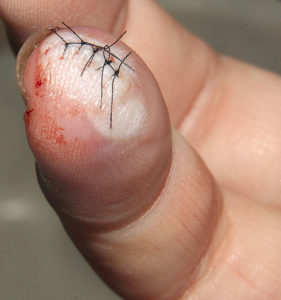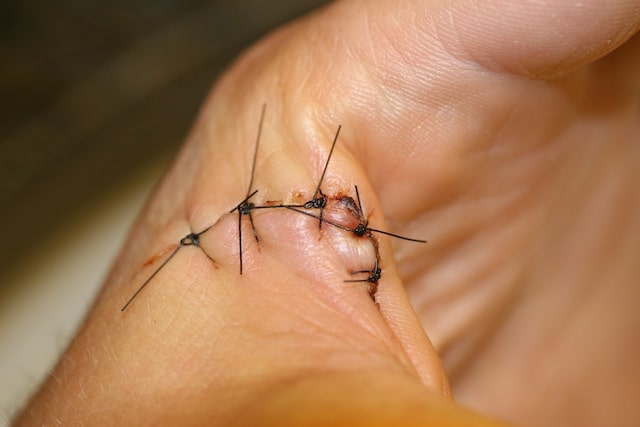Removing sutures (stitches) at home can be done safely if the wound has healed properly, and you follow the correct procedure. However, it’s crucial to consult a healthcare professional before attempting this on your own to ensure that the wound is ready for Suture Removal At Home in Dubai. This guide provides a detailed step-by-step process to help you remove sutures at home safely.
What You’ll Need
Before you begin, gather the necessary supplies to ensure a clean and safe removal process:
- Sterile scissors (or suture removal scissors)
- Tweezers (preferably sterile)
- Antiseptic solution (e.g., alcohol wipes or hydrogen peroxide)
- Sterile gloves (optional but recommended)
- Sterile gauze or cotton balls
- Sterile bandages or adhesive strips
- Soap and water

Step-by-Step Guide to Removing Sutures
1. Wash Your Hands Thoroughly
Before starting, wash your hands thoroughly with soap and warm water to minimize the risk of infection. It is important to maintain a sterile environment throughout the process. If you have sterile gloves, put them on after washing your hands.
2. Clean the Wound Area
Using antiseptic wipes or a cotton ball soaked in antiseptic solution, gently clean the area around the sutures to remove any dirt, bacteria, or dried blood. This step is essential to reduce the risk of infection during the removal process.
3. Inspect the Wound
Ensure that the wound has healed properly. The edges of the wound should be closed, with no gaps, redness, swelling, or discharge. There should be no pain or tenderness around the area. If the wound looks inflamed or infected, do not proceed with suture removal and consult a healthcare professional.
4. Set Up Your Tools
Disinfect the scissors and tweezers by soaking them in antiseptic solution or using alcohol wipes. Ensure that the tools are sterile to avoid introducing bacteria into the wound.
5. Grasp the Knot of the Suture
Use sterile tweezers to gently lift the knot of the suture. Be careful not to tug or pull too hard, as this could damage the wound or surrounding tissue.
6. Cut the Suture
Once the knot is lifted, use sterile scissors to cut the suture thread. Cut as close to the skin as possible, but be careful not to cut the skin. Cutting close to the skin reduces the risk of pulling bacteria or debris through the wound during removal.
7. Pull Out the Suture
After cutting the suture, use the tweezers to gently pull out the thread by pulling on the knot. The suture should slide out easily. If you feel any resistance or discomfort, stop and consult a healthcare professional.
8. Repeat for Each Suture
Continue this process for each suture. Remove them one by one, making sure to cut and pull each thread carefully. Take your time to ensure all stitches are removed smoothly.
9. Clean the Area Again
After all sutures have been removed, clean the area once more with antiseptic solution to disinfect the wound site.
10. Apply a Sterile Bandage
If the wound is still slightly open or you notice any mild bleeding, apply a sterile adhesive bandage or gauze to protect the area and promote further healing. You can also use adhesive strips (e.g., Steri-Strips) to keep the wound edges closed if necessary.
11. Monitor for Signs of Infection
After the suture removal, keep an eye on the wound for signs of infection, including redness, swelling, warmth, discharge, or increasing pain. If any of these symptoms appear, seek medical attention promptly.
Aftercare Tips
- Keep the Wound Clean: Clean the area daily with mild soap and water, and apply an antiseptic as necessary.
- Moisturize and Protect: Use a healing ointment or moisturizer to keep the skin hydrated, which can help minimize scarring.
- Avoid Sun Exposure: Protect the healing skin from sun exposure by using sunscreen or covering the area with clothing.
- Monitor for Infection: Watch for any signs of infection and consult a doctor if you notice any unusual symptoms.
When to Seek Medical Help
Suture removal at home is generally safe for simple wounds, but there are times when you should seek medical assistance:
- The wound shows signs of infection, such as redness, swelling, warmth, or discharge.
- The wound has not fully healed, and you are unsure whether the sutures should be removed.
- There is significant pain when attempting to remove the sutures.
- You are unable to remove the sutures completely or encounter resistance.
Conclusion
Suture removal at home can be done safely if you follow the proper steps and use sterile tools. Always consult with a healthcare professional before proceeding to ensure that the wound has healed appropriately. If you have any doubts or concerns during the process, it’s best to seek professional help to avoid complications such as infection or wound reopening. Proper aftercare is essential to ensure smooth healing and minimize scarring after suture removal.





Comments